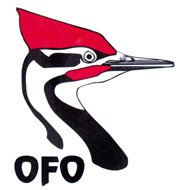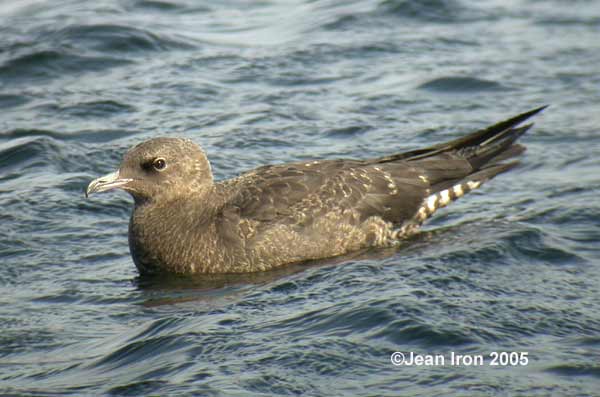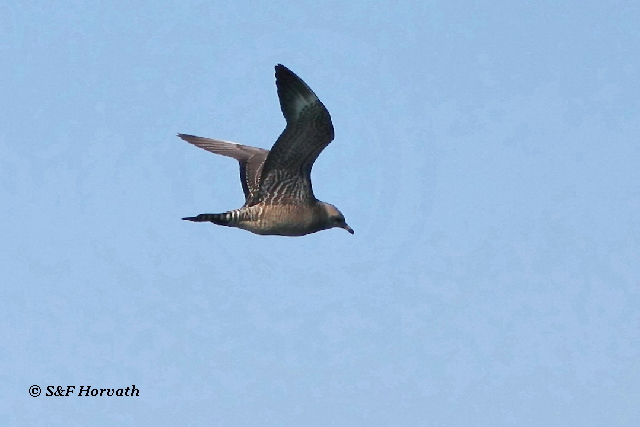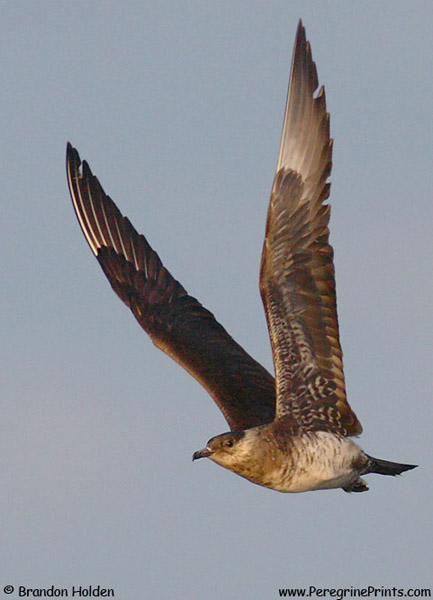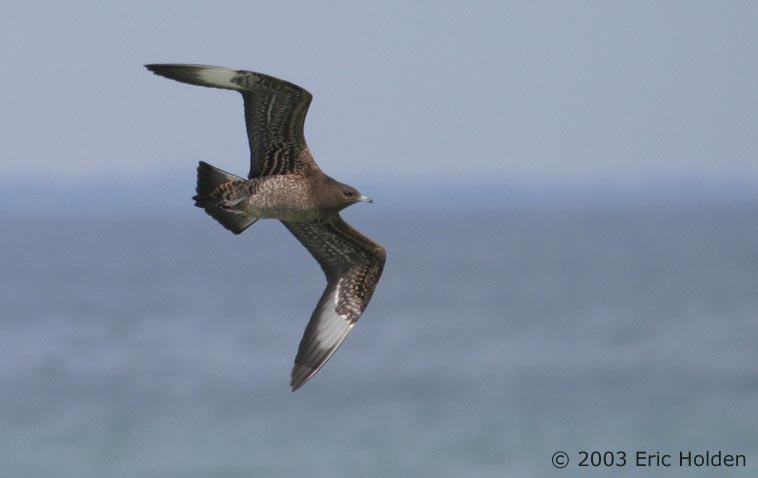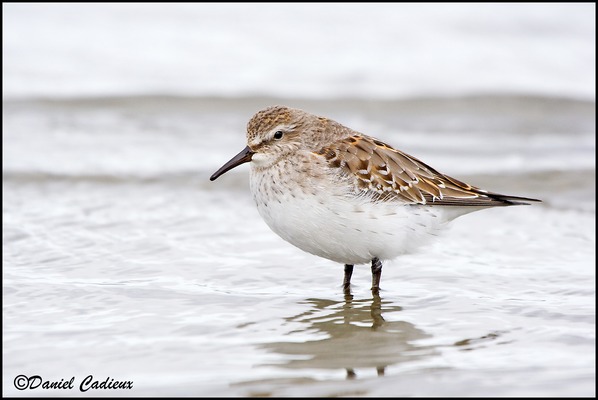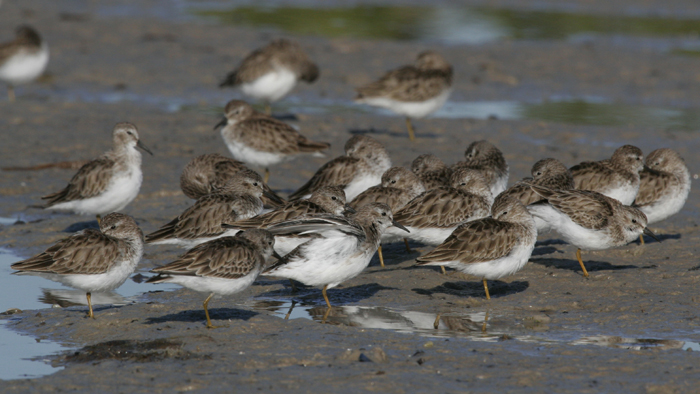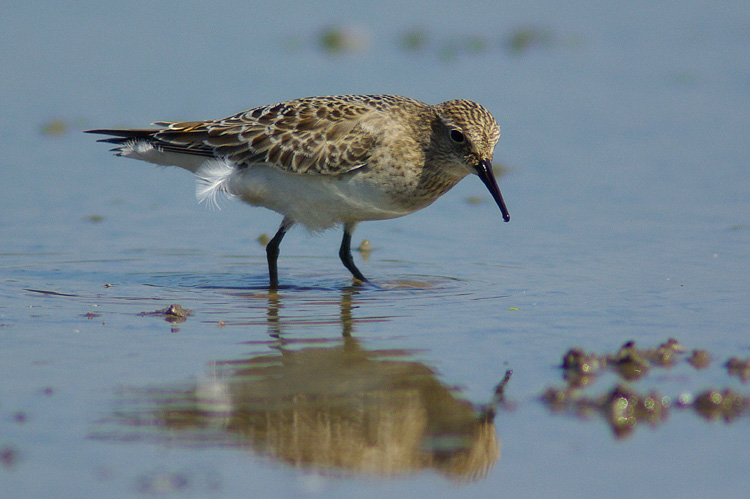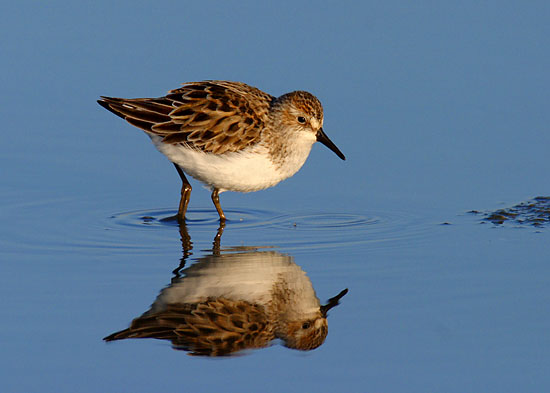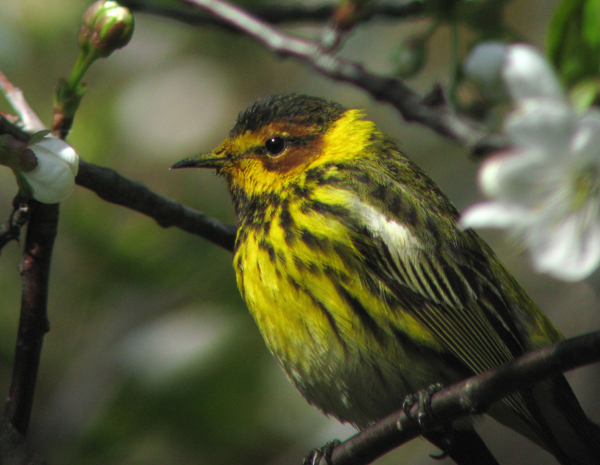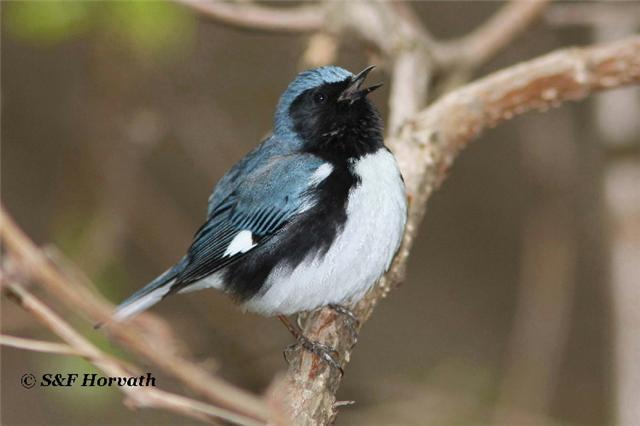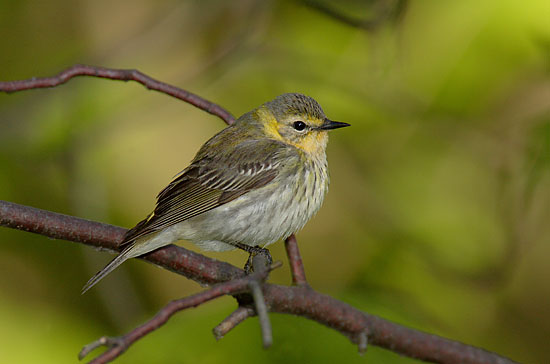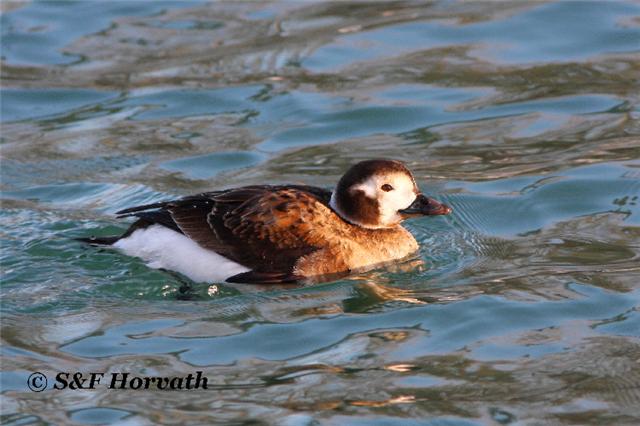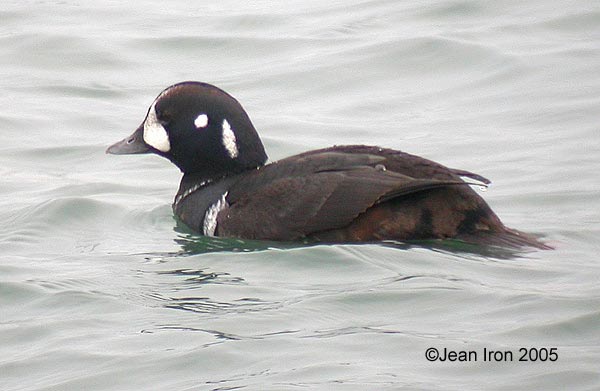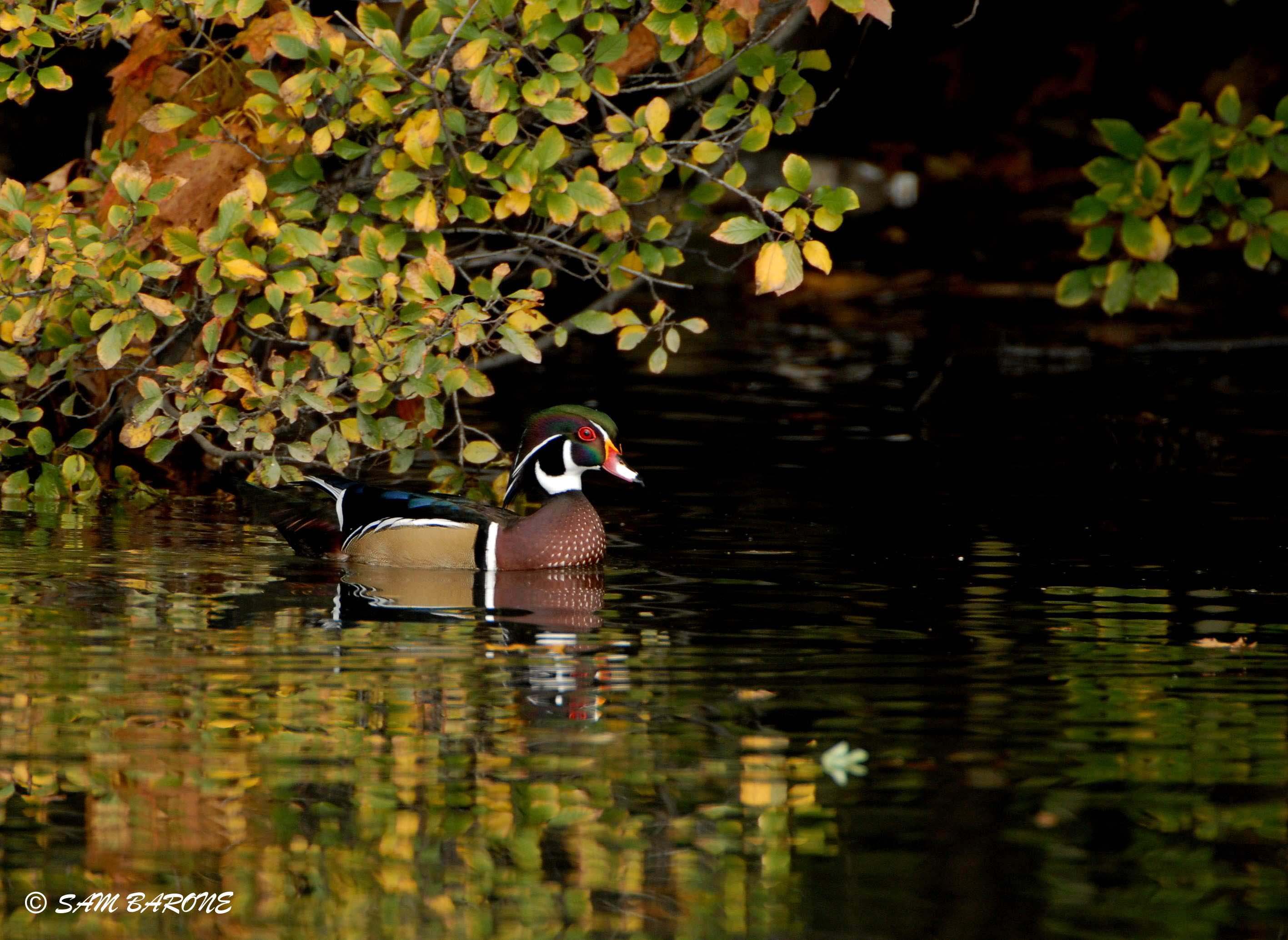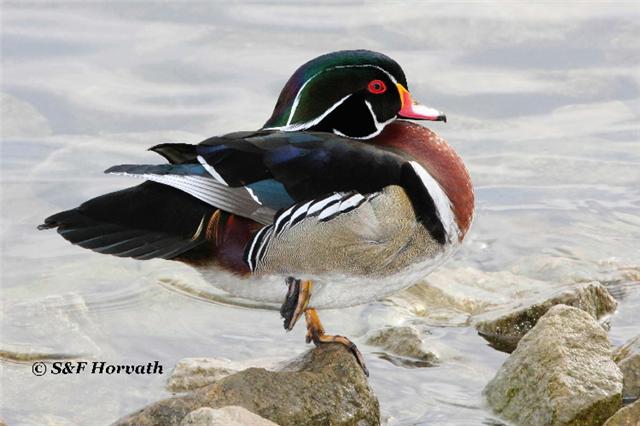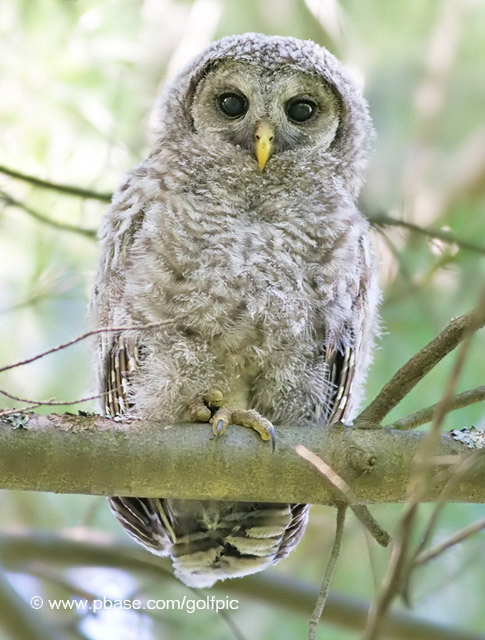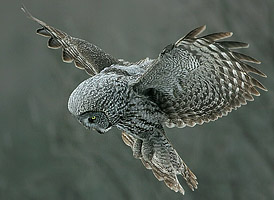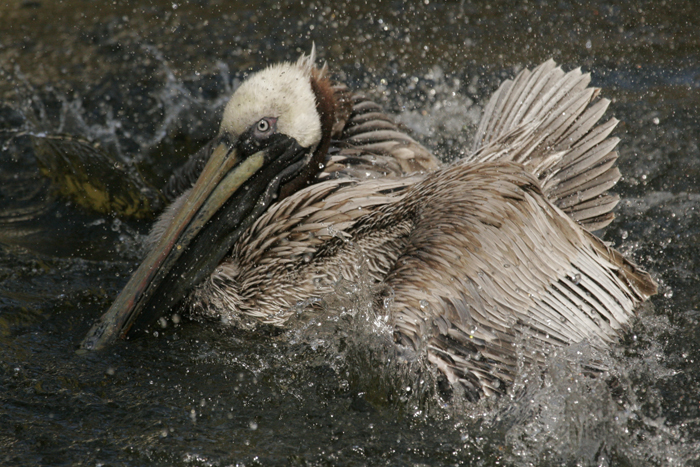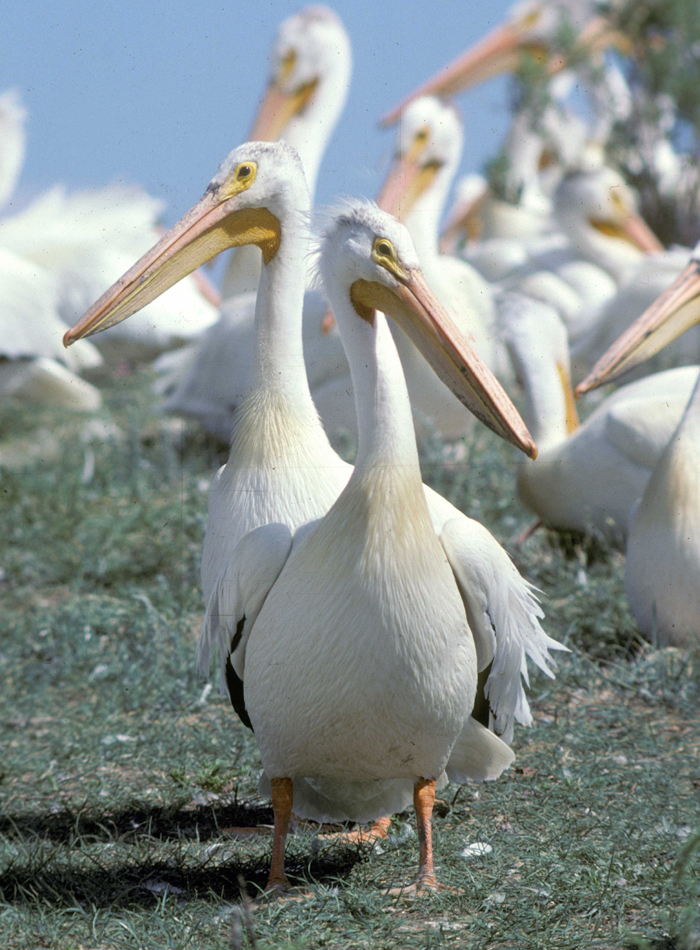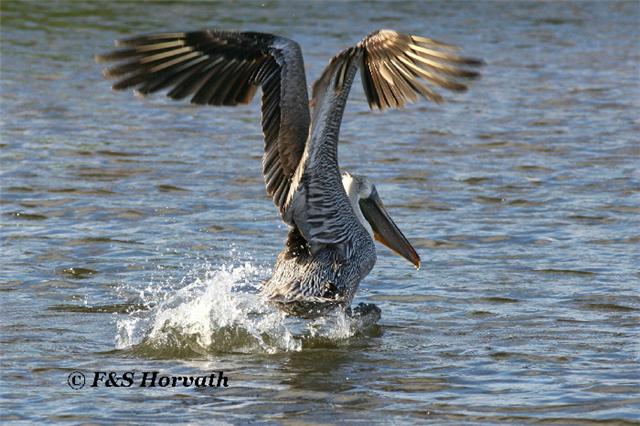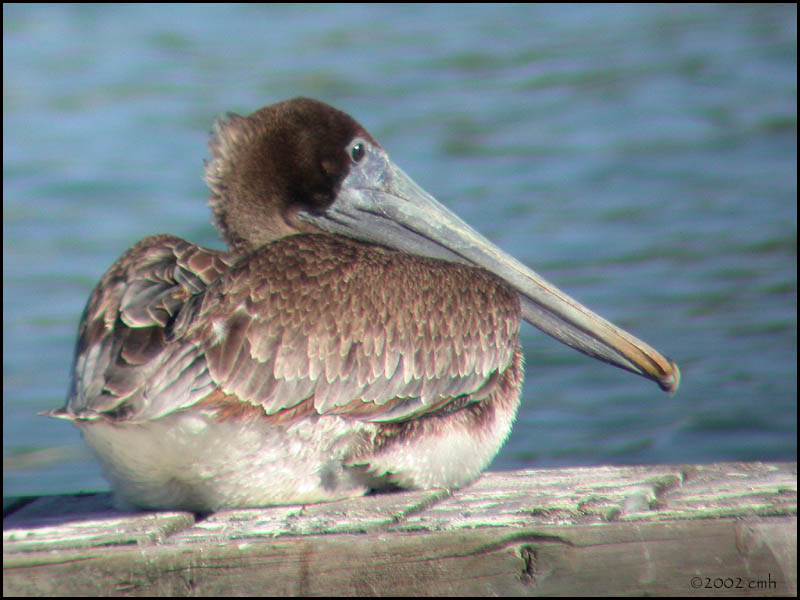September 10 2022 (Saturday) Hamilton
Leader: Rob Porter, Barry Coombs.
Approximately, 35 participants gathered at 8am at Van Wagner's Beach for the OFO Hamilton 2022 outing. The co-leaders were Barry Coombs and Rob Porter. It was already a hot and sunny day for our blend of beginner, intermediate and experienced birders. Winds were not favourable for lake-watching so jaegers were not on the menu but passerines, raptors and shorebirds provided us with lots of action. The group walked the local ponds and across the bridge to Globe Park before returning to the parking lot by another route parallel to the beach. Twelve species of warblers were observed as well as several other species. Our second stop was in Burlington at Woodland Cemetery. The shade was welcome and we added to our day total with three more warbler and two vireo species. A highlight was an extremely cooperative Philadelphia Vireo. A stroll downhill brought us to Valley Inn and the low water level had provided some excellent shorebird habitat. Nine shorebird species were seen including three Short-billed Dowitchers, which were a bit distant and strongly backlit. They were later confirmed as SBDOs from photos. Overall, 76 species were tallied by our sharp-eyed participants. Thanks to all for making the outing a success.
September 22 2018 (Saturday) Hamilton, Burlington & Vicinity
Leader: Richard Poort.
Today 15 people joined in for a short walk along the Hamilton waterfront near Hutches. Winds were good for a lakewatch, but due to time constraints we moved inland. We had 40 species in 2 hours. Highlights were a Yellow-billed Cuckoo showing well for a few members in the group and a few early Hermit Thrushes. Birding was a little slow, but the company was good. Thanks to all who joined in and let's hope next year is better. If you want me to share the ebird checklist from today, please feel free to email me.
September 24 2016 (Saturday) Hamilton, Burlington and Vicinity
Leader: Rob Porter.
Today at 8 am a group of about 32 birders were treated to quite a showing of fall migration activity at Van Wagners beach & ponds, as well as at Windermere Basin and later at the Lakeland centre. Our first patch at Van Wagners Ponds was so filled with migration activity we advanced at a snails pace, taking a full 2.5 hours to get through due to an abundance of migrant passerines. Highlights were White-throated Sparrows by the dozens, White-crowned Sparrows, Golden-crowned and Ruby-crowned Kinglets, Red-breasted Nuthatches, a pair of Blue-headed Vireos, a number of Yellow-bellied Sapsuckers, a couple Orange-crowned Warblers, a Philadelphia Vireo, two Brown Thrashers, Eastern Phoebes, Winter Wrens, Yellow-rumped Warblers, Common Yellowthroats, a Black-throated Green Warbler, Blackpoll Warblers, Magnolia Warblers, Dark-eyed Juncos, Blackburnian Warbler, Wilson's Warbler, Nashville Warbler, Red-eyed Vireos.. and those were just the highlights. We then headed over to Windermere Basin, which also did not disappoint. Some observed species included Hudsonian Godwit, Dunlin, Baird's Sandpiper, Least Sandpiper, Pectoral Sandpiper, Greater Yellowlegs, Black-bellied Plover, Northern Shoveler, Osprey, American Kestrel, Ruddy Duck, Caspian Tern, Green-winged Teal, Lesser Scaup, and a couple resting Turkey Vultures. After lunch, some stayed around to see if jaegers would appear at Lakeland. The number an observer got to see depended on how long they stayed. A few got to see a Parasitic Jaegar at a distance, and some also got to see two more unidentified jaegars also at a distance. Also of note were a couple Sanderlings, as well as migrant warblers and kinglets passing by -- something not often seen at Lakeland centre. Thanks to all that attended, and thanks to Caleb Scholtens for taking down our records for eBird, and to all those who helped others out with shorebird and fall warbler IDs.
October 3 2015 (Saturday) Hamilton, Burlington and Vicinity
Leader: Len Manning.
Despite the less than stellar conditions with very high winds, 26 birders uncovered exactly 70 species by trips end - down 11 from last year, but given the wind, I thought we may have a chance at the fewest number seen on an OFO outing. Passerines were difficult to nail down, and some very common species were missed as a result. These included American Goldfinch, Downy Woodpecker, and House Finch. The highlight of the trip was discovered by yours truly at Windermere Basin. Just as we were about to leave, I scanned the shoreline one last time and discovered a sub-adult PARASITIC JAEGER resting on one of the small islands in the basin. The bird was studied in scopes for about 6 or 7 minutes and then, as if on cue, stretched its wings, flew around the basin, and directly over our heads at close range. Excellent looks and photos were taken, and this was a life bird for about half the trip attendees. 2 young LESSER BLACK-BACKED GULLS were seen at various times at Hutch's, one decidedly more mottled than the other. Other highlights included: - Eastern Meadowlark at Windermere Basin - Merlin (f) at Windermere Basin and another (m) at Van Wagners Ponds - 9 Common Terns at Tollgate Pond and 1 at Windermere Basin - Ruddy Turnstone near the CCIW seen after lunch by some observers - Black-bellied Plover and Sanderlings at Windermere Basin - a very late Yellow-bellied Flycatcher at Van Wagner's Ponds I thank everyone that attended, and Andrew Don, Dan Macneal, Kevin Shackleton, and Wayne Renaud for their assistance in getting others on the birds, and I thank Dave Milsom for organizing all of the OFO field trips. Participants e-bird checklists will be completed and shared by tomorrow morning. If I miss you, please send me a reminder.
October 4 2014 (Saturday) Hamilton, Burlington and Vicinity
Leader: Len Manning.
With strong SW winds and rain overnight,with similar conditions continuing nearly right until the trip started, I admit the outlook for the trip looked a bit bleak. Nevertheless, nearly 40 faithful birders met this morning at 8 AM at Hutch's on the Beach for the annual Hamilton OFO trip.
Conditions for lake watching were far from ideal and early scans of the lake turned up very little save 3 common gull species and 4 Greater Scaup. With this in mind, we started birding immediately at Van Wagners Ponds. Things definitely started slow, winds continued to blow and birds were hard to come by. The ones that we did see were skittish and did not show well at all. Flyover Common Loons and Common Merganser were noteworthy however.
About 45 minutes into the trip, the sun came out and things really started to pick up at the east end of Van Wagners Ponds where we encountered large groups of passerines.The majority of these birds were the vanguard of the later expected migrants such as White-throated Sparrows, Kinglets, and Brown Creepers. However a strong showing of 15 Winter Wrens was a good count for the species. Fox Sparrow, Brown Thrasher, Rose-breasted grosbeak, Swainson's Thrush and Yellow-bellied Sapsuckers were highlights for some.
Warblers were well represented with Yellow-rumped, Nashville, Magnolia, Palm, Black-throated Green, Cape-May (photographed), Northern Parula and a highlight for many in the group was an Orange-crowned Warbler seen by many as it was catching insects in a goldenrod patch.
The crown jewel of the day came when the group watched a migrating Peregrine Falcon fly inland off the lake, only to be dive bombed and hit by a second Peregrine Falcon. As if that was not good enough, a third Peregrine was sitting atop a hydro tower screaming at all the action, allowing for excellent looks.
After a heart healthy lunch break at Hutch's, we continued to Windermere Basin where winds were high and problematic for viewing. However, good birds were still had. A late juvenile Broad-winged Hawk was seen by some of the group and a getting late Osprey was another high flying migrant.
Shorebirds were well represented with Greater and Lesser Yellowlegs, Black-bellied Plover, Semipalmated Sandpiper, Dunlin with a getting late Least Sandpiper and a late Samipalmated Plover.
Overall the group tallied 81 species. A respectable number for a day that did not have ideal conditions. I thank Lisa Teskey for compiling and Andrew Don helping with leading the trip. Thanks also to everyone who attended and helped put others on birds. It was a team effort and a fun filled day. I look forward to the next one.
October 5 2013 (Saturday) Hamilton, Burlington and Vicinity
Leader: Tom Thomas.
A large group of enthusiastic birders (40+) showed up at Hutches' On The Beach, for what turned out to be a pretty good day of birding. Conditions were overcast, mild, and a good east wind was blowing in from the lake. We counted a conservative estimate of 84 species, but not everyone saw every species, as some of the group elected to stay at the beach where the birding was as good as it's been in the history of field trips that I have led to this area. An adult Gannet, all three Jaeger species as well as a Black-legged Kittiwake, Forster's Tern, Lesser Black-backed Gull, Common Loon, and a Red-necked Phalarope were some of the highlights.
For those members who wanted to join in the hike around Hutches' Ponds, the Windermere Basin, and nearby Confederation Park, some of the more notable species were....Peregrine Falcon, Merlin and American Kestrel, Dark eyed Junco, Purple Finch, Eastern Kingbird, Yellow-bellied Sapsucker, Brown Creeper, Eastern Phoebe, Orange-crowned, Nashville, Northern Parula, Black-throated Blue (f) Black-throated Green, Palm, Blackpoll, and Yellow-rumped Warblers were spotted.
At Windermere Basin, the only shorebird here were a single Killdeer, and a couple of Dunlin. Duck species..Northern Pintail, Green-winged Teal, Northern Shoveler, Ruddy Duck, American Widgeon, and a couple of Pied-billed Grebes. Later in the day we saw three Yellowlegs (sp) flying over Confederation Park.
Some members took the drive into Hamilton / Cootes Paradise, in search of the American White Pelican that's been around most of the week, they managed to find it, and also saw their first American Tree Sparrows of the season.
Overall it was a most enjoyable day, and I hope everyone had as much enjoyment as I did.
October 8 2011 (Saturday) Hamilton, Burlington & Vicinity
Leader: Tom Thomas.
On Saturday October 8th 2011, 23 avid birders met at Hutches’ on the Beach Strip, on what was a perfect day to look for birds. I have found from experience, that perfect days don’t always mean that there are lots of birds around. I did some scouting mid week, and there were lots of birds to be found, but by Friday most of these birds had left, and on Saturday morning we had to really search hard with meager results.
The lake was as calm as a mill pond, and the winds if any, were not favorable to blow in any of the rarer species.
Having said all that, we did however find some nice birds. On the trails behind Hutches’ we saw Black‐throated Blue, Common‐yellowthroat, Eastern Towhee, Rusty Blackbird, Trails Flycatcher, Field Sparrow, and Yellow‐bellied Sapsucker.
A trip out to the Windermere Basin (there is some extensive rehabilitation work going on here, and there is no longer a large pond forwaterfowl) was good for Black‐bellied Plover, White‐rumped Sandpiper, Pectoral Sandpiper, Dunlin, Killdeer and Spotted Sandpiper. Other species found here were, Northern Shoveler, Green‐winged Teal, Northern Pintail, Lesser Scaup, Northern Mockingbird, and Horned Lark.
After lunch most of the group wanted to check out the Dundas Marsh, which proved to be a good decision. Here we found Yellow‐rumped Warbler, Red‐bellied Woodpecker, Marsh Wren, Swamp Sparrow, Nelson’s Sparrow (a few of the sparrows showed well, and most of the group had good looks at what was a life bird for some of them), Hudsonian Godwit, and a soaring Goshawk.
In total we had 75 species which I would have jumped at before the trip started.
Here is the final species tally for the members who participated.
- Canada Goose
- Mute Swan, Mallard
- Blue‐winged Teal
- Northern Shoveler
- Northern Pintail
- Green‐winged Teal
- Lesser Scaup
- Double‐crested Cormorant
- Great Blue Heron
- Great Egret
- Black‐crowned Night‐Heron
- Turkey Vulture
- Sharp‐shinned Hawk
- Cooper's Hawk
- Northern Goshawk
- Red‐tailed Hawk
- Black‐bellied Plover
- Killdeer
- Spotted Sandpiper
- Hudsonian Godwit
- White‐rumped Sandpiper
- Pectoral Sandpiper
- Dunlin
- Ring‐billed Gull
- Herring Gull
- Rock Pigeon
- Mourning Dove
- Red‐bellied Woodpecker
- Yellow‐bellied Sapsucker
- Downy Woodpecker
- Trails Flycatcher
- Eastern Phoebe
- Blue Jay
- American Crow
- Horned Lark
- Black‐capped Chickadee
- White‐breasted Nuthatch
- Brown Creeper
- Carolina Wren
- Marsh Wren
- Golden and Ruby ‐crowned Kinglet
- American Robin
- Gray Catbird
- Northern Mockingbird
- European Starling
- Cedar Waxwing
- Black‐throated Blue and Yellow‐rumped Warbler
- Common Yellowthroat
- Eastern Towhee
- Field
- Nelson's
- Song
- Swamp
- White‐throated Sparrow
- White‐crowned Sparrow
- Northern Cardinal
- Red‐wing Blackbird
- Rusty Blackbird
- Brown‐headed Cowbird
- House Finch
- American Goldfinch
- House Sparrow.
I would like to thank Anthony Miller for keeping score, Barry Cherriere for pointing out the shorebirds at the Windermere Basin, and to all those who turned out for the field trip, and hopefully had a good time.
October 9 2010 (Saturday) Hamilton, Burlington and Vicinity
Leader: Tom Thomas.
For the 40 or so members that showed up at Van Wagners Beach on a picture perfect Saturday morning, it was a question of quantity of birds over quality.
The winds were perfect for Jaeger watching, but unfortunately we were looking into the early morning sun, and all the bird activity was on the far horizon. We did manage to pick out a number of Bonaparte’s Gulls, and flocks of Long‐tailed Ducks however.
Walking along the Waterfront Trail, we saw many Yellow‐bellied Sapsuckers, Brown Creepers, Golden and Ruby‐crowned Kinglets, White‐crowned, White‐throated, and Chipping Sparrows.
The ponds and trails behind Hutches were good for Hermit Thrush, Eastern Phoebe, Least Flycatcher, Orange‐crowned, Black‐throated Blue, and Nashville Warblers, Fox Sparrow, Song Sparrow, Field Sparrow, White‐throated Sparrow, and perhaps a hundred or more Juvenile White‐crowned Sparrows, I suspect the ratio of adults to juveniles was about a hundred to one in favor of the juveniles.
The timing of our walk on the trail behind Hutches was fortunate for one particular bird. A sharp eyed birder spotted something in a bed of Burdock. On further investigation we found a Golden‐crowned Kinglet with its wings and breast feathers totally snagged. The bird was still alive, although it looked like it was exhausted, and ready to give up, we gently untangled it, and it flew a couple of yards into some nearby Goldenrod, where hopefully it can quietly recover.
After lunch we took a trip to the Windermere Basin, to look for ducks and shorebirds, there was lots to look at here, but a scope is a must to identify the distant shorebirds and the large mix of waterfowl. Some of the highlights here were a late Barn Swallow, and an Orange‐crowned Warbler that popped up and sat for a while on some Goldenrod, giving us great looks.
From the Windermere Basin we backtracked to Confederation Park, where this year the birding was less than stellar, but we did add an Eastern Wood‐Pewee, and Wood Duck to the tally.
There were just a couple of birders left when we decided to check out the lake in a last effort to see a Jaeger. Fortunately for us Cheryl Edgecombe was looking at two distant jaegers as we arrived at the Lakeland viewing area. We both agreed that these were more than likely Parasitic Jaegers, as this is the species that goes after gulls in a big way, and this is what these two birds were doing.
At the end of the day we counted a total of 78 species, which is a pretty good effort when the birding gets tough.
List of Species
Canada Goose, Mute Swan, Wood Duck, Gadwall, American Black Duck, Mallard, Northern Shoveler, Northern Pintail, Green‐winged Teal, Redhead, Ring‐necked Duck, Greater Scaup, Lesser Scaup, White‐winged Scoter, Long‐tailed Duck, Ruddy Duck, and Common Loon.
Double‐crested Cormorant, Great Blue Heron, Black‐crowned Night‐Heron.
Sharp‐shinned Hawk, Cooper’s Hawk, Red‐tailed Hawk, American Kestrel, Merlin, and Peregrine Falcon.
American Coot, Black‐bellied Plover, White‐rumped Sandpiper, Pectoral Sandpiper, Dunlin.
Bonaparte’s Gull, Great‐Black‐backed Gull, Ring‐billed Gull, and Herring Gull.
Parasitic Jaeger.
Rock Pigeon, Mourning Dove.
Yellow‐bellied Sapsucker, Northern Flicker.
Easter Wood Pewee, Least Flycatcher, Eastern Phoebe.
Blue‐headed Vireo.
Blue Jay, American Crow.
Barn Swallow.
Black‐capped Chickadee, Red‐breasted Nuthatch, Brown Creeper, Winter Wren, Golden and Ruby‐crowned Kinglets.
Hermit Thrush, American Robin, Gray Catbird, Northern Mockingbird, Brown Thrasher.
European Starling, Cedar Waxwing.
Orange‐crowned, Black‐throated Blue, Black‐throated Green, Nashville and Yellow‐rumped Warblers.
Eastern Towhee, Chipping, Field, Fox, Song, Swamp, White‐throated, White‐crowned Sparrows, Dark‐eyed Junco.
Red‐winged Blackbird, House Finch, Goldfinch, and House Sparrow.
I would like to thank everybody who took the time to make this trip so enjoyable, and I hope to see you next year.
October 10 2009 Hamilton, Burlington and Vicinity
Leader: Tom Thomas.
First of all I would like to thank the many participants of today’s trip, for a very enjoyable and memorable outing.
Approximately 40 birders were at Hutches at Van Wagners Beach for the 8:am start. A couple of lucky birders who where early arrivals had the chance to see a Parasitic Jaeger harass a Double‐crested Cormorant before most of us had arrived. With fairly benign winds, the action at the beach was fairly slow, but we managed to spot groups of White‐winged Scoters, Bonaparte’s Gulls, three Common Loons, a juvenile Bald Eagle, and a lake bound Merlin.
We then walked down the beach and at Baranger’s, we crossed over to the fields and ponds to the west of Van Wagners Beach Road. There were many birds to be found here, not all of them very co‐operative for long looks however. Some of the highlights were Cooper’s Hawk, Greater Yellowlegs, Yellow‐bellied Sapsucker (many), Eastern Phoebe (many), Tree Swallow, Northern Rough‐winged Swallow, Barn Swallow, Winter Wren, Eastern Bluebird, Hermit Thrush, Swainson’s Thrush, a late Veery, Palm Warbler, Ovenbird, Wilson’s Warbler, Common Yellowthroat, Chipping, Lincoln’s, Field, White‐crowned, White‐throated and Swamp Sparrows, Winter Wren, Black‐crowned Night‐Heron, and Great Egret.
After lunch we headed for Windermere Basin, where Red‐tailed Hawks and American Kestrels were hunting. In the pond were Gadwall, American Wigeon, Northern Shoveler, Northern Pintail, Green‐winged Teal, Canvasback, Redhead, Lesser Scaup, Bufflehead, Canvasback, Hooded Merganser and Pied‐billed Grebe. The highlight though was the Short‐eared Owl that flushed from the side of the path and then circled high above some obviously delighted birders.
Our last stop was to the grounds of Confederation Park A (the north side). Some of the highlights here were a close encounter with a hunting juvenile Redtail, Orange‐crowned, Tennessee, Blackpoll, Nashville and Palm Warblers, Eastern Phoebe, Eastern Wood‐Pewee, and many more Hermit Thrushes and Yellow‐bellied Sapsuckers.
Our final Tally was 86 species, not too bad, considering we saw virtually no shorebirds.
11 October 2008 Hamilton, Burlington vicinity
Leader: Tom Thomas.
The OFO’s annual field trip to the Hamilton/Burlington area was enjoyed by a small but enthusiastic group of birders. With the OFO convention held in Hamilton barely a week ago, and the fact that was a Thanksgiving weekend, I did not expect the usual number of participants. That being said, the eleven birders who made the trip were some of the most eager and enthusiastic people you could wish to lead. In fact there were still some who wanted to keep birding well into the afternoon and early evening.
We met at Hutch’s on Van Wagners Beach, and spent the first hour there, always hoping to see Jaeger or two, but although the wind direction was good it was far too light for any action. One of the first birds we saw here was a Red‐throated Loon flying overhead, and the only birds close enough to identify were a Red‐necked Grebe, and some White‐winged Scoters. The fields and ponds behind Hutch’s were good for Hermit Thrushes, Eastern Towhee’s, warblers(Black‐throated Blue, Nashville, Palm and Yellow‐rumped), Green Heron, Pied‐billed Grebe, Lincoln Sparrow, and flyover Rusty Blackbirds, American Pipits, and a late Osprey.
After lunch we then proceeded to the Windermere Basin, where we had a good tally of ducks, but the highlight here was the discovery of a recently arrived Brant Goose. Shorebirds at Windermere this year was restricted to a couple of Greater Yellowlegs and a lone Dunlin. Our next stop was the Dundas Marsh, or the Willows to be more specific. Here most of the group had good looks at one of two Nelson’s Sharp‐tailed Sparrows we encountered in a patch of Manna Grass just off of the main trail. These birds were in a very accessible area that was discovered just days ago by a local birder.
After saying goodbye to most of the group, a few of us headed to Tim Horton’s, and on to Valley Inn, where we added a few more species to our list. So a very good day, with lots of birds to look at, and our total species count was 80, not too bad for Hamilton in October
Reported by Tom Thomas
7 October 2007 Hamilton, Burlington and vicinity
Leader: Tom Thomas.
Once again this field trip proved very popular, with 48 participants at the start. Despite moments of fierce thunder and close lightning strikes during the morning stretch, we still had 25 semi‐wet people for the latter part of the day. We found 73 species, which was pretty good considering the warm weather lately and the fact that the only warblers we found were Yellow‐rumped Warblers. The winds at Van Wagners were not good for Jaeger watching and anything at a distance was lost in the haze. Nevertheless we did get some close looks at Common Loons flying overhead, and a flock of Bonaparte’s Gulls.
We spent the first hour at Van Wagners Beach and then we headed for the adjacent wet land area across the road from Hutches restaurant. As we entered this area, a young Peregrine Falcon was spotted on the hydro tower and it flew by us several times. As we approached the ponds we could see that a storm was coming in fast, which was disappointing as we were starting to see some good birds, including a Red‐necked Phalarope, but those carrying telescopes were getting worried at seeing all the lightning, so we made a hasty return to Hutches. After an early lunch we then headed to the Windermere Basin. This newly restored wildlife area will soon be open to the public, but they are awaiting the results of soil testing before they make this decision. I was lucky enough to be checking it out on Friday, and the workers were kind enough to give me a key to open the gates so that we could drive into the car park. At the Windermere basin the duck species and numbers were really impressive, we also managed a few sparrow species here along with some shorebirds in the creek near the bridge on Eastport Drive. The best surprise however was to see the variety of shorebirds in the small pond near the railroad track at Pier 25. Here we found a Long‐billed Dowitcher, Wilson’s Snipe, Baird’s Sandpiper, Semipalmated Plover, Solitary Sandpiper, Greater and Lesser Yellowlegs, Pectoral and Least Sandpipers.
The group then headed to LaSalle Park, where we added a few more species to the list, and then headed out to Valley Inn for our final stop. We had only just arrived at Valley Inn, when again the skies looked ominous, and in a matter of minutes we went from looking at the beautiful white reflected image of a Great Egret in the late afternoon sun, to looking at a pair of Rusty Blackbirds foraging in the mud in a torrential rainstorm. With all the interruptions from the frequent thunderstorms, I think a good days birding was had by all, and several of our group managed a couple of lifers, and that’s what it’s all about.
Reported by Tom Thomas.
7 October 2006 Hamilton, Burlington and Vicinity
It was a glorious early fall day, and as it usually seems to happen, the better the weather, the fewer the birds. We spent the first hour or so, at Van Wagners Beach, where we spotted a single Bonaparte’s Gull among the Ring‐billed Gulls on the shore‐line. Further out there were White‐winged Scoters, Surf Scoters, and as Dave Milsom scoped a raft of scaup, a Pomarine Jaeger chasing a gull.
The trails and marshes behind Hutches yielded less than the expected species, but we were rewarded with great close up looks at Hermit Thrushes, the only birds along with White‐throated Sparrows, Ruby‐crowned Kinglets and Yellow‐bellied Sapsuckers seen in good numbers. After lunch we moved along the lakeshore to Shoreacres Park. Birds there proved to be just as elusive, but this was more than made up with the sight of over sixty Red‐necked Grebes just off shore.
The last stop of the day was at Shell Park, where again the summer‐like conditions were not ideal for finding fall birds, but we did add a few more species.
At the end of the day we totaled just over fifty species, not great, but it was wonderful to be out on such a perfect day, testing our bird finding skills to the limit.
Reported and led by Tom Thomas.
8 October 2005 Hamilton, Burlington and Vicinity
Leader: Tom Thomas.
This was again a most successful field trip to the Hamilton/ Burlington area, with birders from as far away as Presqu‘ile and one visitor from Arizona.
The group was primarily based at Van Wagners, where the early surprises were a fly past of four, then 18 Brant. Other birders picked out Forster's Tern, and Common Tern as well as distant sightings of Parasitic Jaegers. An Osprey appeared over Hutch's Restaurant, and then a Peregrine Falcon flew out over the lake and returned, only to hang motionless in the wind for a while. We then checked out the old Rail Trail opposite Hutch's, where we were rewarded with a good variety of birds, the highlights being Eastern Meadowlark (7), a flight of 14 Black-crowned Night-Herons, a Green Heron, and Lincoln, Field and Fox Sparrows. It was then back to Hutch's for lunch, where birders were treated to the sight of 6 jaegers, later a Red Phalarope flew in. The tour continued on to Shoreacres and Shell Park, where the birding continued to be good-- Tennessee, Black-throated Green and Nashville Warblers gave us close up looks. Hermit Thrushes were the bird of the day, seemingly popping up everywhere. It was then back to Van Wagners Beach, via Windermere Basin, for a final effort to find more Jaegers, but only a couple appeared on the far distant horizon.
In all we tallied eighty one species, not bad for October in Hamilton/Burlington.
Reported by Tom Thomas
11 October 2003 Hamilton, Burlington, Stoney Creek and Vicinity
Leader: Kevin McLaughlin.
An enthusiastic group of approximately 21 OFO menbers came for a car/walking trip to several sites in the Hamilton-Burlington area. About 50 species were seen and the outing lasted from 8 a.m. until around 3 p.m. Areas visited were Van Wagners Beach and ponds, Burlington Beach Canal woods, Shoreacres Creek woods and trail on the Burlington lakeshore and the Valley Inn area at the west end of Hamilton Harbour. A dense fog shrouded the lake and harbour, reducing the number of species that could be seen. Regardless, there was a good mix of passerines, waterfowl and shorebirds available. Sparrows were in good numbers, particularly at Van Wagners and included numerous White-throats and White-crowns along with two each of Field Sparrow and Eastern Towhee. Valley Inn provided a late juvenile Green Heron and five Stilt Sandpipers. It was at this location that the afternoon sun broke through the fog and allowed excellent 'scope viewing of the birds on the pond and mudflats. This brought the day to a happy conclusion for all present.
Reported by Kevin McLaughlin
12 October 2002 Hamilton, Burlington, Stoney Creek and Vicinity
Leader: Kevin McLaughlin.
On our trip to Hamilton's Van Wagners Beach and surrounding area, the group saw 67 species. The highlight was a very close view of a Red Phalarope molting from juvenal to first basic plumage at Pier 24 in Hamilton Harbour. The other seven species of shorebirds included Greater and Lesser Yellowlegs, Pectoral Sandpiper, Dunlin, Semipalmated Plover, Least Sandpiper and Killdeer.
A Red-necked Grebe was seen well in Hamilton Harbour off the Canada Centre for Inland Waters.
We saw 18 species of ducks on Lake Ontario and in Windermere Basin where there were lots of Ruddy Ducks. White-winged Scoters, Long-tailed Ducks and a large raft of scaup were on Lake Ontario. Several Common Loons and Common Terns flew by.
A Peregrine Falcon with a satellite transmitter was eating a bird on one of the hydro towers just east of the Van Wagners ponds.
Two jaegers flying beyond the wave tower were seen by a few of the group.
Reported by Jean Iron
